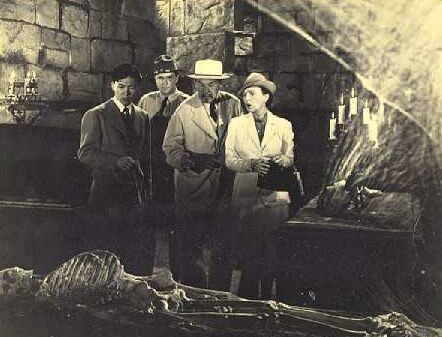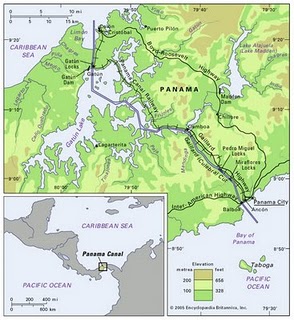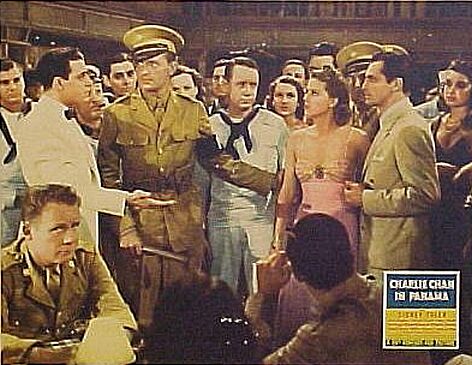One thing that is frequently
underestimated about Charlie Chan in Panama is the importance of various types of planes at this point during world
unrest . . . so read on for some extra credit on background . . . .
Aviation During World War II
| Are Charlie and Company Solving a Crime |

|
| Or Going Trick or Treating?! |
Charlie Chan in Panama
(1940)
Charlie Chan in Panama.
. . . Or is he?
He's under cover as Fu Yuen, owner of a hat store and on the look out for a gang of spies among international travelers who
may--or, like Fu Yuen, may not!--be what they seem!
All this with a background of Panama's nightlife, Military Police, and . . . being held in a crypt!
Yes, Maven said crypt!
Charlie Chan (Sidney Toler), Jimmy (Victor Sen Young), and Captain Lewis (Don Douglas) investigate a cemetery and come
across a mausoleum that they decide to check out.
They
find an old maid teacher on vacation as Jimmy leans against a back wall and takes a tumble.
This crypt that looks average-sized on the outside has a false wall leading to stairs down to a room that looks larger than
most apartments that Maven has seen lately!
Who has that complicated a crypt, not to mention that size?!
Okay . . . so there's a mausoleum in Fort Worth, Texas, that has had Maven's interest for years!
Don't ask or she'll tell you about half the cemeteries in her area!
| The Panama Canal |

|
| Or; A Root Canal You'll Enjoy! |
Building the Panama Canal
Theodore Roosevelts Legacy: The Panama Canal
Want to travel through the Canal for fun and to
get some feel of what it might have been like at the time of Charlie Chan in Panama?!
| Don't You Love the Guy in the Lower Left Corner?! |

|
Panama Canal - Defending the Canal
The military’s
presence in the Panama area dates back to before the United States constructed the canal, when it protected U.S. merchant
trade lanes. Even during construction, the military supplied engineers, labor, and security. Fortification of the Canal Zone was only partially completed by 1913. The Hay-Buana-Varilla
Treaty gave the United States the right to fortify the zone, but it was not until 1911 that Congress appropriated the funds
to begin fortification construction. With Sydney Williamson as construction supervisor and Army engineer Major Eben E. Wilson
the design engineer, construction began that year on three forts on the Atlantic side and two on the Pacific. In 1912 the
Chief of Engineers organized a section in his office under Goethal's son, Army engineer Lieutenant George R. Goethals, to
oversee fortification construction in the Canal Zone. The first Atlantic fort was operational in 1914 and the first on the
Pacific side in 1916. By the time the United States entered World War I, there were nine operational forts at each end of
the canal.
In 1917 the United
States hastily acquired the Danish Virgin Islands, to counter a possible wartime flaw in the canal’s defenses, ensuring
they were not obtained by imperial Germany. Base rights in Trinidad were an important element of the Lend-Lease destroyer
deal with the UK in 1940, the justification for these facilities being coverage of the southern routes through the Caribbean
islands toward the Panama Canal. Also during World War II the United States was watchful of Martinique and Guadeloupe when
these French West Indies islands in the were in under Vichy control. The US was prepared to seize them by force if need be
to preclude their use by hostile forces.
During the 1930's,
events and technological developments began to challenge the old axioms on which the defense of the Canal had been based.
A crippling attack aimed at the locks and dams, and delivered either by an act of sabotage or by naval bombardment, had always
been considered the only real danger to be guarded against. The possibility of hostile forces establishing a beachhead and
moving overland to the Canal was not entirely discounted, but the absence of suitable landing places on the Atlantic side
and the thick jungle of the Pacific lowlands were counted on to discourage any attack of this sort. The Army had disposed
its defenses accordingly.
During the 1930's
new instruments for delivering an attack emerged in the shape of the naval aircraft carrier and long-range bomber. Potential
air bases from which an attack against the Canal might be launched came into being as a result of the growth of commercial
aviation in South and Central America. Experience in jungle maneuvers was beginning to make a myth of the impenetrability
of tropical forests. Finally, the Army's ability to move outside the Canal Zone and take defensive measures within the territory
of the Republic of Panama was sharply curtailed by the changing relationship between the two countries. Although sabotage
remained the most likely danger, air strikes by either land-based or carrier-based planes came to be regarded as the most
serious threat because of the wider holes in the defense against them.
Plans for protecting
the Canal against sabotage during an international crisis of this sort had been drawn up in Panama and given constant study
ever since the spring of 1936. In 1939, These measures were instituted between 26 August 1939, when the President gave the
signal to go ahead, and 01 September 1939. Three basic measures had been provided for: first, the installation and operation
of special equipment in the lock chambers, designed to detect underwater mines and bombs and to prevent damage from this cause;
second, the restriction of commercial traffic to one side of the dual locks; and third, the inspection of all ships before
they entered the Canal and the placing of an armed guard on vessels while in transit through it.
Soon photography
of Canal installations was banned for the duration of the war, mines were placed at both entrances to the Canal, low-altitude
barrage balloons were placed over the locks with anti-submarine and torpedo nets placed in front of the locks, and chemical
smoke pots were positioned throughout a 60 square mile area. The massive guns and batteries on military installations at either
end of the Canal were prepared for use. The 6 to 16 inch (in.) guns were housed in 11 Atlantic and 12 Pacific batteries, and
had a range up to 25 miles. To protect against air attack, anti-aircraft batteries were put in place across the Zone and two
antiaircraft detachments were sent in September 1939. Two long-range radar stations were also established in the autumn of
1939.
Immediately after
the Japanese attack on Pearl Harbor, the War Department instructed its department commanders to put the Rainbow 5 plan into
effect. This was the Orange Plan, which identified the Japanese as the primary aggressor, and singled out the Panama Canal
as one of the key defense initiatives.
By the time the
build-up was complete, defenses consisted of nine airbases and airdromes, 10 ground forces posts, 30 aircraft warning stations,
and 634 searchlights, antiaircraft gun positions and miscellaneous tactical and logistical installations. Twelve outlying
airbases were also constructed in Peru, Ecuador, Guatemala, Nicaragua, and Costa Rica. An outer defense parameter of 960 nautical
miles from the Canal was established and patrolled by air and sea.
When the United
States found itself enmeshed in a two ocean war, the Panama Canal suddenly became the most strategic point on the globe. The
convergence of naval and merchant fleet traffic at this point offered German U-boats a vital and tempting target. As a result, it became necessary to ring the canal's ocean approaches
with protective bases. Agreements with the governments of Caribbean, Central American, and South American countries made it
possible to secure sites for new bases throughout the area. The Lend Lease Agreement, consummated with Great Britain in September
of 1940, yielded still other possible bases in this crucial locale. Not only were new base sites rapidly acquired, but United
States bases already in existence were enlarged. Under the Greenslade Program of 1940, the three pre-1939 naval installations
located in Puerto Rico, Cuba, and the Panama Canal Zone were all expanded.
THE CAST*:
Sidney Toler: Charlie Chan (also posing as Fu Yuen)
Jean Rogers:
Kathi Lenesch (also known as Kathi von Tzardas and Baroness von Tzardas)
Lionel Atwill: Clivedon Compton
Mary Nash:
Miss Sarah Finch (billed as Miss Jennie Finch; alias Reiner)
Sen Yung: Jimmy Chan
Kane Richmond: Richard Cabot
Chris-Pin Martin: Lieutenant Montero (billed as Sergeant Montero)
Lionel Royce: Dr. Rudolph Grosser
Helen
Ericson: Stewardess
Jack La Rue: [Emil] Manolo (alias Ramon Gonzalez)
Edwin Stanley: Governor [D.C.] Webster (also
known as Colonel D.C. Webster)
Don Douglas: Captain Lewis
Frank Puglia: Achmed Halide
Addison Richards: [R.J.]
Godley
Edward Keane: Dr. Fredericks
Charles Stevens: Spy on Dock (not credited)
Max Wagner: Soldier (not credited)
Alan Davis: Soldier (not credited)
Charles Sherlock: Soldier
(not credited)
Eddie Acuff: Sailor (not credited)
Harold Goodwin: Military Police Officer (not credited)
Gloria Roy:
Hostess (not credited)
Lane Chandler: Officer at Powerhouse (not credited)
Edward Gargan: Plant Workman (not
credited)
Philip Morris: Plainclothesman (not credited)
Albert Morin: Hotel Desk Clerk (not credited)
Jimmy Aubrey:
Drunk at Club (not credited)
Brooks Benedict: Nightclub Dancer (not credited)
Chuck Hamilton: Dancer (not credited)
Franklin Farnum: Marine Officer (not credited)
*Courtesy of
www.charliechan.info.
|

